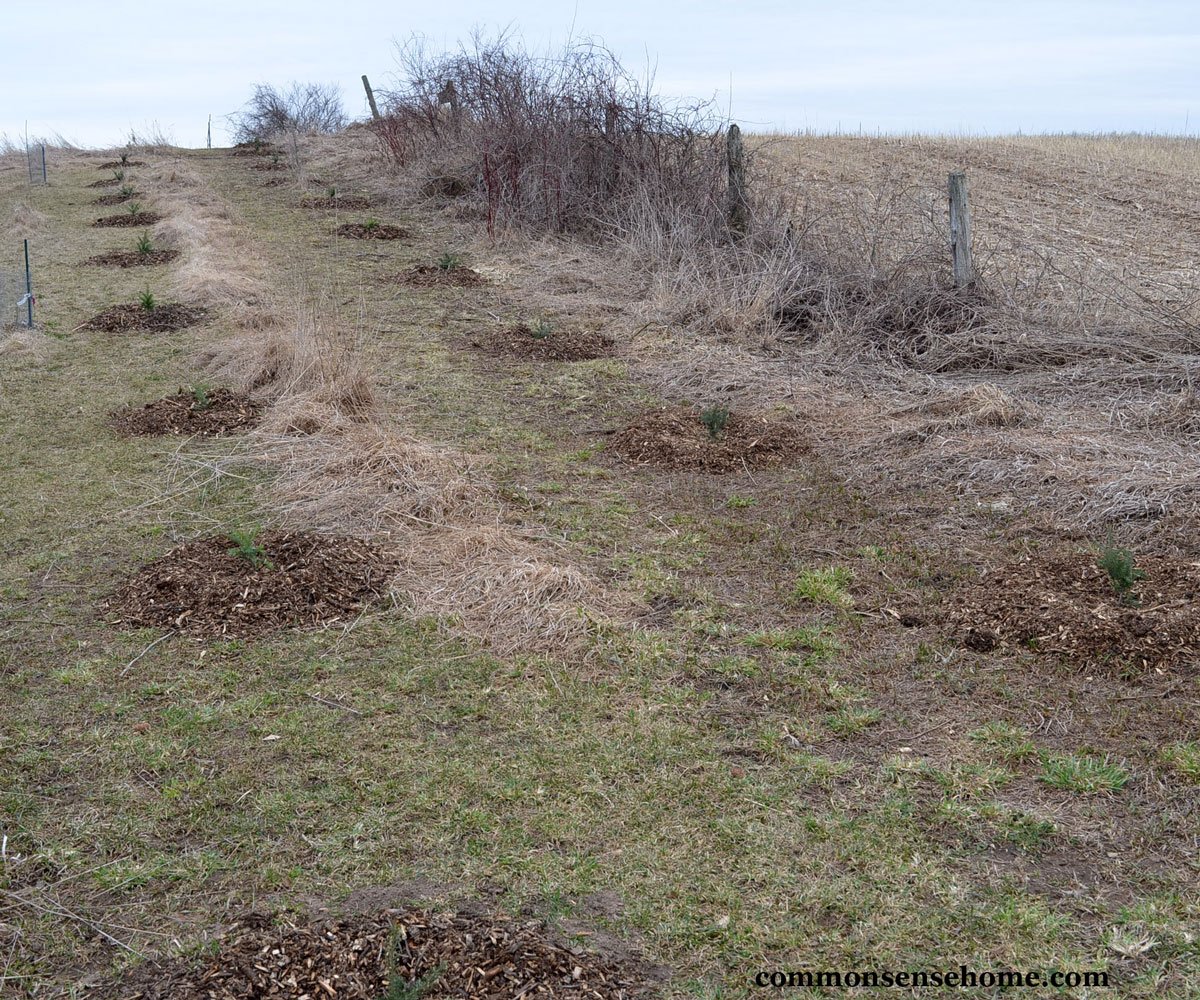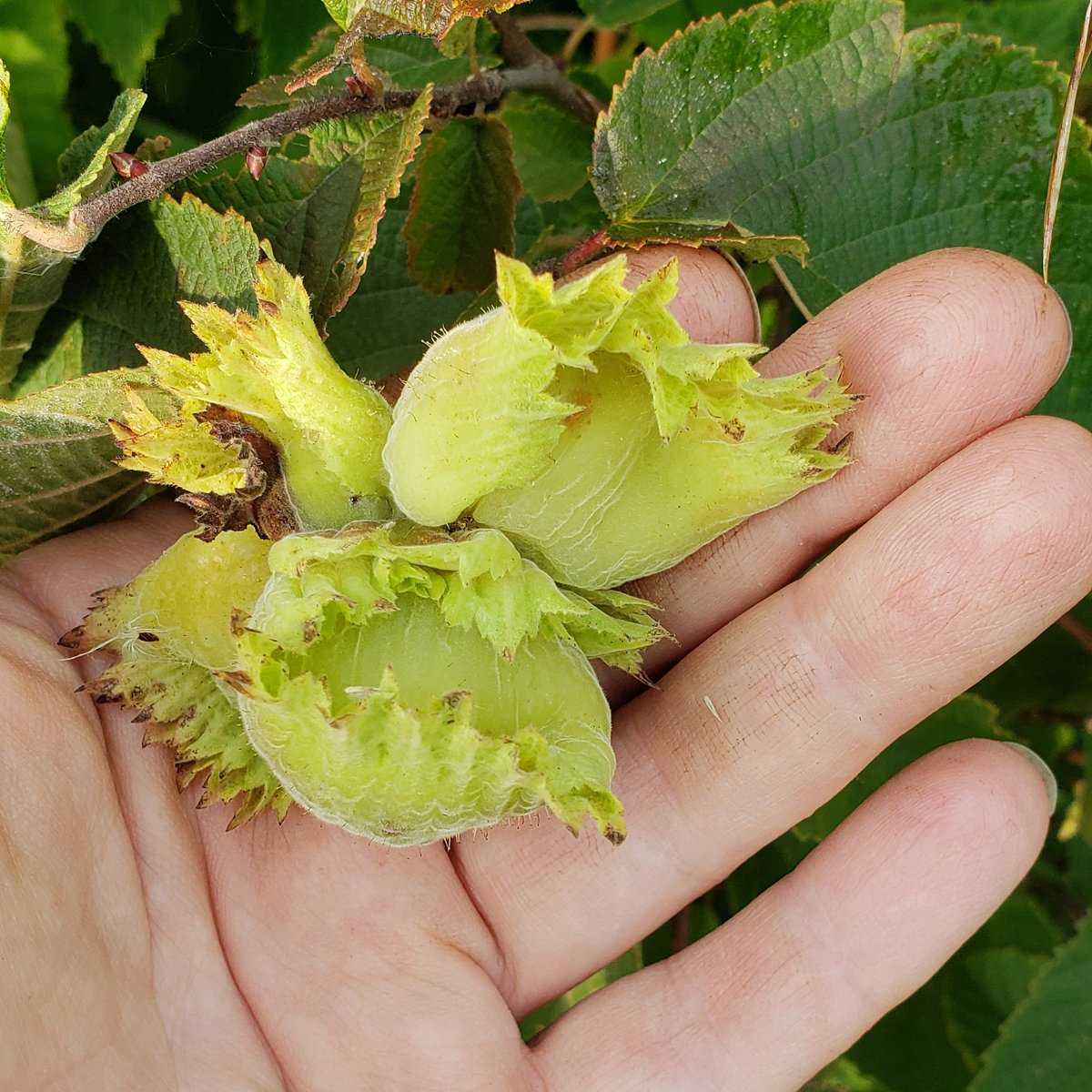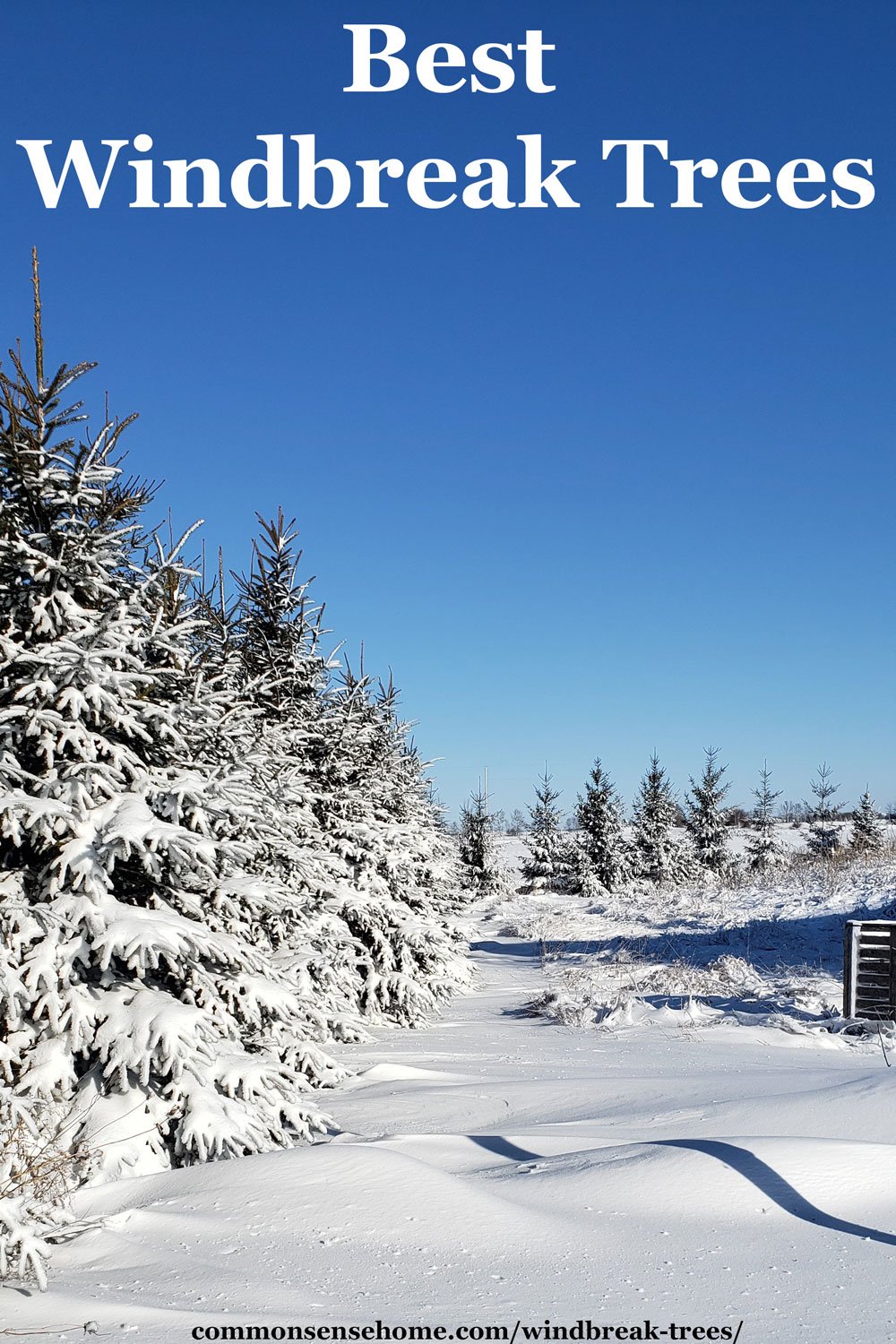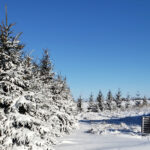Best Windbreak Trees for Warm or Cold Climates
This post may contain affiliate links. Read my full disclosure here.
Selecting the right windbreak trees is important to create a long lasting shelterbelt. Windbreak trees can be part of a food forest, reduce heating and cooling costs, and more.
- See “Windbreaks – You’ll be Amazed at What They Can Do” for more information on benefits.
- “Windbreak Design: Maximize Your Land’s Potential” discusses locating and sizing your shelterbelt.

How to Pick Trees for a Windbreak
The best windbreak trees are those suited to your local environment. Check temperature range, acidity, altitude, moisture levels, diseases, infections and other environmental conditions.
Tree Height: The taller the primary line in the windbreak the more area the windbreak protects.
Tree Density: A tall, tight evergreen such as a Blue Spruce blocks more wind than a short deciduous tree. A double row of tall evergreens is roughly equal to 5 rows of densely planted tall deciduous trees. 60% to 80% density is a “dense windbreak” and is best in northern areas. Less dense is used for special circumstances, such as large open fields.
Altitude: Some trees will not grow well in higher altitudes.
Climate: Make sure your trees match your USDA zone. For instance, if you are growing in a dry conditions, you need drought tolerant trees.
Pest and Disease Resistance: Pick trees that are less likely to have problems with known pests and diseases in your area.
Growth Rate: Fast growing means you get the windbreak quicker, but also consider how long the tree will live. A mix of short and long lived trees is best if you want fast protection that won’t all die at the same time.
Compatibility: Make sure you pick trees that go together. A black walnut will exclude almost all other trees from the tree line. A highly acidic soil will not work for a tree or shrub that does not like acidity.
Purchase Local if Possible
If possible, purchase shelterbelt plants from a local nursery that grows the trees. These trees should be well adapted to your area. If purchasing mail order, try to match your climate.
For help finding trees, contact your local agriculture office or University extension. They should be able to help you identify the best trees for your local area. Neighbors or farmers who have lived in the area for a long time may be another good resource.
Windbreak Trees – Evergreen vs Deciduous
Evergreen trees are the best for reducing wind in areas that have snowfall. They are dense and tall. Two rows of tall evergreens such as blue or white spruce are roughly equal to 5 rows of tall deciduous trees such as chestnut, hickory, oak, walnut, birch or maple.
Best Trees for Northern and Midwest Windbreaks
These trees are for areas that see temperatures from 100°F to -20°F (zones 3-7). Evergreens such as: Blue Spruce, Red Spruce, White Spruce and White Pine are the best for northern and Midwest wind protection. (Note white pine has some common diseases associated with it.)

Best Trees for Southern Dry Area Windbreaks
Trees that can deal with hot and dry include: Arizona Cypress, Boxelder, Aleppo pine, Junipers Honey Locust, Mulberry and Oak trees. Taller trees are preferred. White oak gets more than 40ft tall and the evergreen Live Oak can get to 100ft and is zone 7-10.
For dry areas, a tree line can add 2% to 4% humidity and reduce daytime temps up to 7 °F and increase nighttime temps also. So it cools and heats, and improves moisture levels.
Variety is Important
Any time you have only one type of plant in an area (a monoculture), you set up an all you care to eat buffet for pests or diseases that impact that plant. Trees are no exception to this. Our state has been hit by Dutch elm disease, emerald ash borers, and more.
(Monoculture forests are making news around the world as they fall to disease and weather.)
If you plant multiple species of trees and shrubs, you increase habitat and lower disease risk. You can include evergreens, deciduous, nuts, fruits and berries. Flowering trees will attract beneficial insects.
Would you like to save this?
Windbreak trees can be part of a food forest, providing food and medicine. Plant shorter trees and shrubs on either side of the tall trees at the center of your shelterbelt.

Spacing Windbreak Trees
The planting distance between the rows and individual trees depends on:
- Planting Density: How much wind reduction you want. A dense tree line or a more open tree line for wider turbulence.
- Tree width: Individual shrubs and tree varieties will vary in width and require different spacing based on your goal from #1.
Dense spacing blocks more wind but will shorten the snow drop and protected area. If you want tight spacing, an evergreen tree that is 10ft around needs closer spacing than an evergreen that is 25ft around. You also need to consider if the tree “self prunes” (drops branches) or ends up more “open” when mature.
For northern or dry areas 60% to 80% density is a good goal. In southern areas, shade and 40% to 60% might be a better choice.
It might seem like planting trees close is the best way to keep the wind out. But tightly packed trees will become a problem once they mature. The more space you put between trees in the beginning, the longer your windbreak does its job.
- If you’re planting rows of shorter trees, leave about 10 feet of space between each tree and 15-to-20 feet between each row.
- If you’re planting rows of taller trees, leave 15 feet between each tree and 25 feet of space between rows.
Remember as these trees grow the space, they’ll fill in that space.
If you want faster protection, mix fast growing and slow growing trees. Remove the fast growing trees over time to give the other trees room to grow.

Best Southern Evergreen Trees: (Zone 7-10)
Note: An evergreen based windbreak will need a double row of trees in the tall section to get 60% to 80% density.
- Chinese juniper (Juniperus chinesis “Spartan”) zones 4-9 (2-40ft Tall 15-20ft Wide)
Details: Good tree for the leading edge of a windbreak. Likes moist, well-drained soil. Neutral to slightly acid soil. Blooms. A durable evergreen that’s resistant to deer browsing. Salt tolerant. Can cause skin irritation. - Eastern redcedar (Juniperus Virginiana) zones 2-9 (40-50ft tall 8-20ft wide) grows 13-24” per year. An evergreen that grows about 50 feet tall and loves direct sunlight Can tolerate occasional flooding and is also drought tolerant. Can carry cedar rust to apples.
- Live Oak (Quercus virginiana) Zone 7-10 (40-80ft tall 60-100ft wide) grows 13-24” per year. Details: Full sun, adaptable to lots of soil. Also flood and drought tolerance. Lives for centuries. Great choice for southern deciduous windbreak. Acorns from the tree are edible and are favorites for birds such as: wood ducks, wild turkeys, quail and jays. Also mammals such as squirrels, raccoons and white-tailed deer like them. Can live over 1000 years.
- Salt Cedar Zone 2-9 (5-25ft tall 8-13ft wide) Details: Good shrub for leading edge of windbreak. This long lived deciduous tree has a dense canopy that can help to block the wind. It is also resistant to drought and can tolerate a wide range of soil conditions. Well-adapted to alkaline soils. Lives 50-100yrs
- Sycamore (Latanus occidentalis) Zone 6-10 (40-120ft Tall and 50ft-70ft wide) Details: good tree for tallest section of windbreak. This large, deciduous tree has a broad, spreading canopy that can effectively block the wind. It is also resistant to drought and can tolerate a wide range of soil conditions. Seeds are good wildlife food. Lives up to 250 years.
Best Southern Windbreak Deciduous Trees: (Zone 7-10)
Note: A deciduous windbreak will need 4 to 5 trees deep in the tall section to get 60% density and more to get to 80%.
- Chestnut (Zones 4-9) Size 70-100ft tall
- Cottonwood Poplar (Zone 2-9) Height 50-100ft Width: 50-113ft (height and width vary widely). Details: There are 10+ varieties of cottonwood (poplar), so check zones for compatibility when purchasing. This large, deciduous tree has a broad, spreading canopy that can effectively block the wind. It is well-suited to wetter soils and can tolerate a wide range of soil conditions. They vary widely in lifespan also: narrowleaf and Fremont can live for up to 150 years but Lanceleaf cottonwood will only live up to 50 years.
- Pecan (Carya illinoinensis) Zones 5-9 (70-100 tall and 40-75ft wide). Details: Bears fall edible nuts after 6-10yrs. Zone 5 is questionable unless the nursery is actually growing it locally in zone 5. Confirm details because nut quality, flavor and tree hardiness vary by specific variety and nursery. Lives 200-300yrs.
- Southern Red Oak (Quercus falcata) Zone 6-10 (60-80ft tall and 40-55ft wide). Details: There are a few variations so confirm size and zone details with the nursery before purchasing and planting. Lives 150 to 275 years.
- Sugar Maple (Acer saccharum) Zone 3-8 (60-100ft tall and 40 to 60ft wide) Details: Can be tapped for maple syrup. Drought tolerant. Seeds eaten by wildlife. Not good for zones 9-10. Lives 80-100 years.
- Paper Birch (Betula papyrifera) Zones 2-7 (50-80ft tall and 20-35ft wide) Details: Provides good lumber. Not good in warm areas. lives 25-40 years
- River Birch (Betula nigra) Zones: 4-9 (40-100ft tall and 40-60ft wide) Details: Grows 13 to 24” per year. Cinnamon colored bark, borer resistant. Works well along streams/banks for erosion control. Requires Alkaline soil. Lives 30-75yrs
- Carpathian Walnut (Juglans regia ‘Carpathian’) Zone 5-9 (40-100ft tall 40-60ft wide). Grows 24”+ per year. Details: Edible walnuts after 4 to 9yrs. Has some drought tolerance. Leafs out late in spring. Wind pollinated. NOTE: Produces juglone but not as much as black walnut. Lives 100-200yrs
- Black Walnut (Zone 5-9 (70-100ft tall ft wide) NOTE: Produces large quantities of juglone so other trees, shrub, fruit and berries will not grow under or near the tree canopy. In most cases we DO NOT RECOMMEND it as it will limit your options. Lives 125 to 250 years.
- Tulip Poplar (Liriodendron tulipifera) Zone 4-9 (Height: 70-90ft) Spread Details: Tall and great tree for bees. Can tolerate some drought. Lives 200-300yrs
Best Northern Windbreak Evergreen Trees: (Zone 3-6)
Note: An evergreen based windbreak will need a double row of trees in the tall section to get 60% to 80% density.
- Colorado blue spruce (zones 2-7): Height 80-100ft spread 10-20ft Details: A low-maintenance evergreen with unique color. somewhat drought tolerant. Live 600 to 800 years.
- Douglas fir (Pseudotsuga menziesii) zones 4-6 (coastal is 100ft to 250ft 12-20ft spread and Rocky Mountain is 50-120ft and 20ft spread). Details: A sturdy tree that’s perfect for snowy and icy climates. Two varieties – one variety from northwest “coastal” which is taller and the other is Rocky Mountain. Both get tall and make excellent primary windbreak trees if they match your zone and growing conditions. Coastal live 500 to 1000 years, Rocky Mountain live up to 400.
- Eastern white pine (Pinus strobus) zone 3-8 (75-100ft tall and 30-50 wide). Details: A conifer that grows up to three feet per year. Will grow in boggy areas. Lives 200-450yrs
- Green giant arborvitae (Thuja standishii x plicata ‘Green Giant’) zones 5-7 (50-60ft tall and 12-20ft wide). Details: A fast-growing 1.5 to 3ft per year. Evergreen with a classic pyramid shape. Plant closer due to narrow width. Short Lived 40 to 60 years.
- Norway spruce (Picea abies) zones 2-7 (80-125ft tall 25-30ft wide). Grows 13-24” per year. Details: The fastest growing spruce. Strong and tolerates various soils. Some are are a bit shorter 40-60ft tall – check your nursery source. Lives up to 300 years.
- Ponderosa Pine (Pinus ponderosa) Zone 3-7 (60-100ft tall and 25-30ft wide). Grows 13-24” per year. Details: This tall, coniferous tree has a dense canopy that can help to block the wind. It is also resistant to drought and can tolerate a wide range of soil types. Lives up to 500 years.
- Eastern Red Cedar (Juniperus virginiana) Zones2-9 (40-50ft tall and 8-20ft wide) Grows 13-24” per year. Not suggested if you want apples. Tolerates heat, wind and salt. Lives 100-300 years.
- Western Red Cedar (Thuja plicata) Zones 5-9 (120-150ft, a few as tall as 200ft wide and 30ft wide). Details: Primarily grows on the west coast of USA. Lives up to 1000 years.
- White cedar zones 3-7 (60-80ft tall 15-20ft wide). Grows 13-24” per year. A popular conifer with a long cone shape. Deals with flooding but not drought. A few varieties grow much faster.
- White Spruce (Picea glauca) zones 2-6 (40-60ft tall and 10-20ft wide) grow 12-24” per year. Details: Also known as canadian spruce, black hills spruce, and other names. Prefers acid soils and has some drought tolerance.
- White fir (Abies concolor) zones 4-7 (30-50ft tall and 20ft wide) grows 12 to 24” per year. An evergreen commonly used as a Christmas tree. Prefers acidic soil. Has moderate drought tolerance. Needles are bluish or silvery-green.
Best Northern Windbreak Deciduous Trees: (Zone 3-6)
Note: A deciduous windbreak will need 4 to 5 trees deep in the tall section to get 60% density and more to get to 80%.
- Apple (malus) Zones 4-9 (Dwarf 5-7ft tall and wide, standard 25-30ft and equal width, with some full size trees varying from 25-100ft tall and 20 to 35ft wide) Details: There are hundreds of varieties of apple, so the details vary per tree type. Varieties have different disease and pest resistant, keeping quality (how long they store), amount of sugars and a extremely wide variety of flavors. The apple tree smaller sizes are for dwarf trees and “pole” trees. Live 10-80 or more years, full size generally live longer.
- Chestnut (Zones 4-9) Height 70-100ft tall Details: 4 major species – American Chestnut (Castanea dentata), European Chestnut (C. sativa), Chinese Chestnut (C. mollissima) and Japanese Chestnut (C. crenata). Chestnut blight wiped out most of the American chestnuts, but disease resistant hybrids and cultivars are slowly being reintroduced. Food for humans and wildlife, rot resistant wood, long lived.
- Cottonwood Poplar (Zone 2-9) Height 50-100ft Width: 50-113ft (height and width vary widely). Details: This large, deciduous tree has a broad, spreading canopy that can effectively block the wind. It is well-suited to wetter soils and can tolerate a wide range of soil conditions. They vary widely in lifespan also: narrowleaf and Fremont can live for up to 150 years but Lanceleaf cottonwood will only live up to 50 years.
- Shellbark Hickory (Carya laciniosa) Zone 4-8 (60-80ft tall and 40ft wide) Details: Great wood and depending on the variety good edible nuts. Lives 200 to as much as 300 years.
- Oak (Zone 5-8) Size 40-70ft (12-21 m) Width: Depending on the variety 100 to 600 years.
- Peach (Prunus Persica) zones 4-9 with best being 6 and 7 (4-25ft tall and 4-25ft tall, depending if it is a dwarf or full size tree). Peach are edible stone fruit. They need full sun and well-drained soil. The specific variety matters so research before you buy, to match your growing conditions. Live about 12 to 40 years.
- Pear (Pyrus Spp.) zones 3-10 (4-40ft tall and 3-12ft wide) Details: Pears are edible. They need full sun and well-drained soil. Specific pear varieties have different size, temperature tolerance, preferred soil, pollination and fruit qualities. Research pears before you buy, to match your growing conditions.
- Plum (Prunus domestica) zone 3-9 (4-40ft tall and 4-25ft wide). Details: plums are edible stone fruit. Specific plum varieties have different size, temperature tolerance, preferred soil, pollination and fruit qualities. Research plums before you buy, to match your growing conditions and needs.
- Carpathian English Walnut (Juglans regia) Zone 5-9 (40-100ft tall and 30-60ft wide). Details: Grows 24” per year. Fall nuts are edible. Produces less juglan than black walnut so will cause less tree compatibility issues. Partly self fruitful but best if planted in with more than one tree. Has a taproot so is difficult to transplant.
- Northern Red Oak (Quercus rubra) Zone 3-9 (50-75ft tall and 33-45ft wide). Details: There are a few variations so confirm size and zone details with the nursery before purchasing and planting.
- Southern Red Oak (Quercus falcata) Zone 6-10 (60-80ft tall and 40-55ft wide). Details: There are a few variations so confirm size and zone details with the nursery before purchasing and planting.
- Pecan (Carya illinoinensis) Zones 5-9 (70-100 tall and 40-75ft wide). Details: Bears fall edible nuts after 6-10yrs. Zone 5 is questionable unless the nursery is actually growing it locally in zone 5. Confirm details as nut quality, flavor and tree hardiness vary by specific variety and nursery.
- River Birch (Betula nigra) Zones: 4-9 (40-100ft tall and 40-60ft wide) Details: Grows 13 to 24” per year. Cinnamon colored bark, borer resistant. Works well along streams/banks for erosion control. Requires Alkaline soil. Lives 30-75yrs
- Sugar Maple (Acer saccharum) Zone 3-8 (60-100ft tall and 40 to 60ft wide) Details: Can be tapped for maple syrup. Drought tolerant. Seeds eaten by wildlife. May have good fall colors. Can live more than 400 years.
- Swamp White Oak (Quercus bicolor) Zone 4-8 (50-60ft tall and 50-60ft wide). Details: Some are slower growing. Most grow 13-24” per year for faster ones. Acorns are eaten by wildlife. Can deal with salt, drought, and low lying somewhat wet areas. May have good fall colors. Can live to 300 to 350 years old.
- Tulip Poplar (Liriodendron tulipifera) Zone 4-9 (Height: 70-90ft) Spread Details: Tall and great tree for bees. Can tolerate some drought and live for 200-250 years.
When you pick your plants, remember to mix. If you plant rows of the same tree, you can risk losing your windbreak to a single pest or disease. Alternate between two or three tree types to keep your windbreak up and running.


